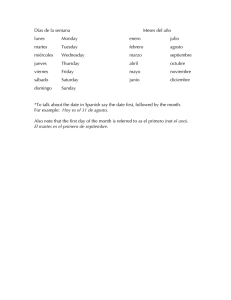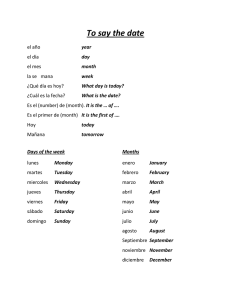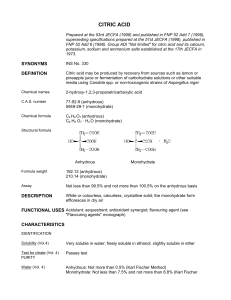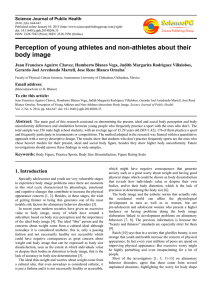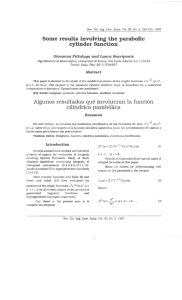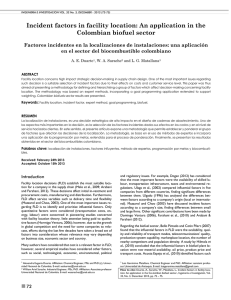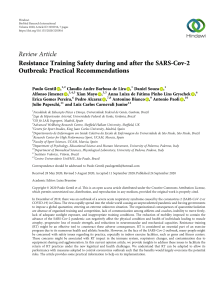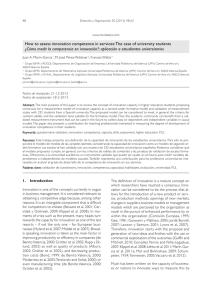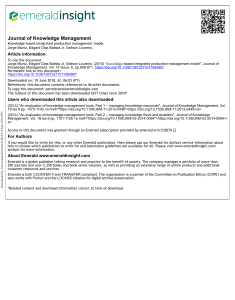pontificia universidad católica del ecuador facultad de comunicación
Anuncio
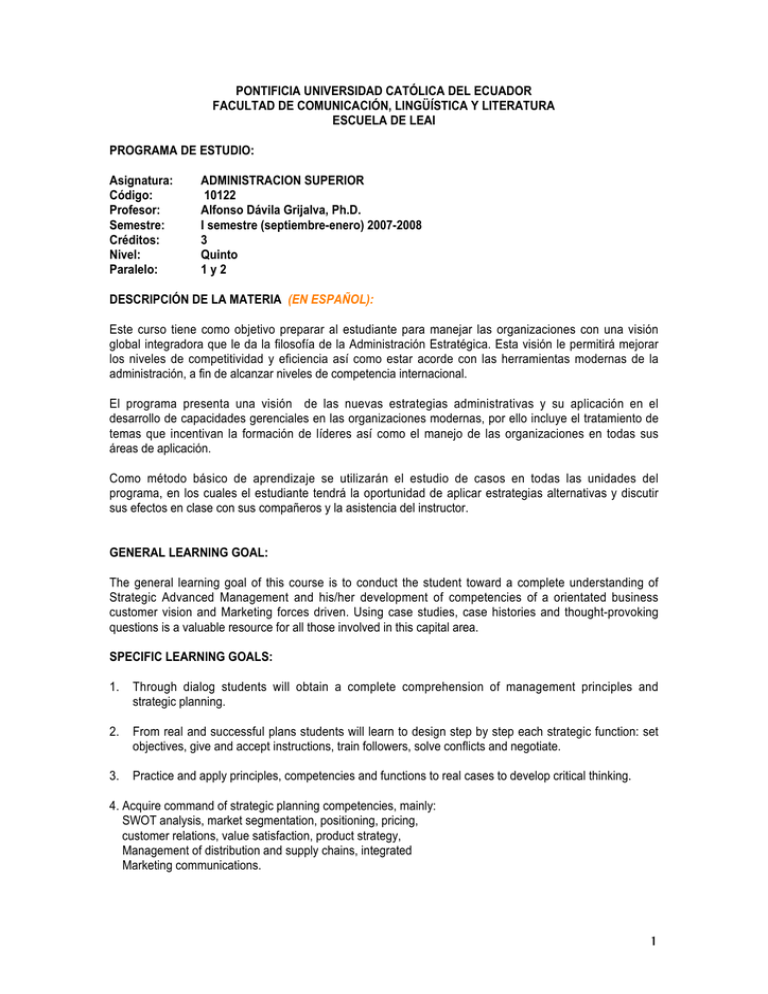
PONTIFICIA UNIVERSIDAD CATÓLICA DEL ECUADOR FACULTAD DE COMUNICACIÓN, LINGÜÍSTICA Y LITERATURA ESCUELA DE LEAI PROGRAMA DE ESTUDIO: Asignatura: Código: Profesor: Semestre: Créditos: Nivel: Paralelo: ADMINISTRACION SUPERIOR 10122 Alfonso Dávila Grijalva, Ph.D. I semestre (septiembre-enero) 2007-2008 3 Quinto 1y2 DESCRIPCIÓN DE LA MATERIA (EN ESPAÑOL): Este curso tiene como objetivo preparar al estudiante para manejar las organizaciones con una visión global integradora que le da la filosofía de la Administración Estratégica. Esta visión le permitirá mejorar los niveles de competitividad y eficiencia así como estar acorde con las herramientas modernas de la administración, a fin de alcanzar niveles de competencia internacional. El programa presenta una visión de las nuevas estrategias administrativas y su aplicación en el desarrollo de capacidades gerenciales en las organizaciones modernas, por ello incluye el tratamiento de temas que incentivan la formación de líderes así como el manejo de las organizaciones en todas sus áreas de aplicación. Como método básico de aprendizaje se utilizarán el estudio de casos en todas las unidades del programa, en los cuales el estudiante tendrá la oportunidad de aplicar estrategias alternativas y discutir sus efectos en clase con sus compañeros y la asistencia del instructor. GENERAL LEARNING GOAL: The general learning goal of this course is to conduct the student toward a complete understanding of Strategic Advanced Management and his/her development of competencies of a orientated business customer vision and Marketing forces driven. Using case studies, case histories and thought-provoking questions is a valuable resource for all those involved in this capital area. SPECIFIC LEARNING GOALS: 1. Through dialog students will obtain a complete comprehension of management principles and strategic planning. 2. From real and successful plans students will learn to design step by step each strategic function: set objectives, give and accept instructions, train followers, solve conflicts and negotiate. 3. Practice and apply principles, competencies and functions to real cases to develop critical thinking. 4. Acquire command of strategic planning competencies, mainly: SWOT analysis, market segmentation, positioning, pricing, customer relations, value satisfaction, product strategy, Management of distribution and supply chains, integrated Marketing communications. 1 CONTENTS: INTRODUCTION • How to analyze a business case. Guidelines for preparing a Case Analyses. • Making an Oral Presentation • Fifty Tips for Success in Case Analysis. • The Mastering Strategy Environment 3.1 THE NATURE OF STRATEGIC MANAGEMENT • • • • • • What is Strategic Management? Key Terms in Strategic Management The Strategic-Management Model Guidelines for Effective Strategic Management What is Strategic Management? Key Terms in Strategic Management The Nature of Global Competition Cohesion Case: American Airlines-2002 3.3 THE BUSINESS MISSION • What do we want to become? • What is our business? • Components of a Mission Statement • Writing and evaluating Mission Statements • Experiential Exercise. 3.4 THE EXTERNAL ASSESSMENT • The Nature of an External Audit • Economic Forces: Social, Cultural, Demographic and Environmental Forces. • Technological Forces. • Competitive Forces: Porter’s Five-Forces Model. The Global Challenge. 3.5 THE INTERNAL ASSESSMENT • The Nature of an Internal Audit • Integrating Strategy and Culture • Marketing Management: Opportunity Analysis • Finance/Accounting, Operations, Research and Development, MIS. • The Internal Factor Evaluation (IFE) • Experiential Exercise: Constructing an IFE Matrix for My University. 3.6 STRATEGIES IN ACTION • Long Term Objectives. Balanced Scorecard as a Strategic Management System • Types of Strategies: Integration Strategies, Intensive Strategies, Diversification Strategies, Defensive Strategies. • Michael Porter’s Generic Strategies • Means for Achieving Strategies, Joint Venture, Merger, Acquisition. • Strategic Management for Nonprofit and Governmental Organizations Strategic Management for Nonprofit and Governmental Organizations • Strategic Management in Small Firms • Experiential Exercise: Lessons in Doing Business Globally. 2 3.7 THE NATURE OF STRATEGY ANALYSIS AND CHOICE • A Comprehensive Strategy Formulation • The Input Stage, the Matching Stage, the Decision Stage. • Cultural Aspects of Strategy Choice • The Politics of Strategy Choice • The role of a Board of Directors • Experiential Exercise: Developing a TOWS Matrix for a Local Company Facing International Challenges. 3.8 IMPLEMENTING STRATEGIES: MANAGEMENT ISSUES • The Nature of Strategy Implementation. Annual Objectives • Policies. • Resource Allocation • Managing Conflict • Matching Structure with Strategy • Restructuring, Reengineering and E-Engineering • Linking Performance and Pay to Strategies. • Managing Resistance to Change • Managing the Natural Environment • Creating a Strategy-Supportive Culture • Human Resources Concerns When Implementing Strategies • Experiential Exercise: Understanding the Culture of an International Organization, like United Nations, OAS etc. 3.9 IMPLEMENTING STRATEGIES: MARKETING, FINANCES, R&D, TOTAL QUALITY, MIS ISSUES • • • • • • • • Marketing Issues Total Quality Management. Competitive Benchmarking: A Technique Utilized by Xerox Corporation. Finance/Accounting Issues Research and Development Issues Management Information Systems International Organization for Standardization Experiential Exercise: Building Strategies to Compete in the European Union. 3.10 STRATEGY REVIEW, EVALUATION AND CONTROL • • • • • • A Strategy Evaluation Framework Sources of Strategy Evaluation Information Characteristics of an Effective Evaluation System. Contingency Planning Auditing Experiential Exercise: Preparing a Strategy-Evaluation Report for American Airlines (AMR). TABLE OF CONTENTS AND CALENDAR: Date Activity/Contents 3 1 2 3 4 5 6 7 8 9 10 11 12 13 14 15 16 17 18 19 3–7 septiembre 10 – 14 septiembre 17 - 21 septiembre 24 - 28 septiembre 1-5 octubre 8-12 octubre 15 - 19 octubre 22 – 26 octubre 29 octubre 02 noviembre 5-9 noviembre 12 - 16 noviembre 19 - 23 noviembre 26 - 30 noviembre 3-7 diciembre 10 - 14 diciembre 17 - 21 diciembre 2-4 enero 7 - 11 enero 2008 14 - 18 enero 2008 How to analyze a business case Guidelines for Effective Strategic Management Business Mission The external assessment PRIMER PARCIAL The internal assessment Strategies in action (I) Strategies in action (II) The nature of Strategic Analysis SEGUNDO PARCIAL Strategic Analysis and Choice Implementing Strategies Implementing Strategies: management issues Implementing Strategies: Marketing TERCER PARCIAL Implementing Strategies: Finances. R&D A Strategy Evaluation Framework A Strategy Evaluation Framework EXÁMENES FINALES Inicio de clases: 3 de septiembre de 2007 Fin de clases: 11 de enero de 2008 Exámenes finales: 14 al 18 de enero/2008 Días festivos: 9 de octubre, 2 noviembre, 6 de diciembre, del 24 de diciembre al 1 de enero de 2008. METHODOLOGY: Use of textbook is a must for everybody. Students will receive their textbook the very first day of class including key supplements like CD and website for homework and projects. Student should read each chapter in advance, before classes and should prepare homework assignments: reading, tests, internet exercises and case discussion. Cases will be solved in teams, where each member will assume the role of an executive specialized in a functional area like Finances, Marketing, Production, Human Resources, or General Management. Each team will present end results that might be reached. 4 Each class period will have one of these three sections: lecture, critical thinking questions, and case discussion. As a final test, each team will develop a business plan for a company that competes with other enterprises in the international market. During last week, each team will present in class their reports of final results of each area and expected total profit. EVALUATIONS: Sections “Reading for Comprehension” and linking concepts to “Practice” and “Case applications”, will count for ten points each. Final test will count for 20 points. 10 points will be assigned to total final results of the enterprise and 10 points for individual performance. Every work will be evaluated according to presentation quality, clear thinking and communication, scientific contents and ability of student to propose or find creative solutions for each concrete problem. Significant contributions to the class will be recognized with one or more “stars”. “Black holes” for failures in your homework will count as -3 points. Grades will be assigned by your teacher at the end of each task. For late papers a 20% discount will be applied. For other regulations check college calendar and agenda. CRITERIA Self-Assessment Exercises End-of-chapter cases Application Exercise GRADE/PERCENTAGE 40% 20% 40% TESTING DATES: (De acuerdo al Reglamento General de la PUCE, las notas deben ser entregadas a Secretaría máximo siete días laborables después de la fecha indicada. Cabe señalar que la última fecha del semestre para tomar pruebas parciales es el 29 de enero del 2007). Primer parcial Segundo parcial Tercer parcial Examen final 10 pts. Octubre 16 10 pts. Noviembre 27 10 pts. Enero 8 20 pts. (puede consistir en 2 notas de 10pts.) EVALUACIONES: Entrega de Notas Primer parcial Segundo parcial Tercer parcial Examen final 10 Pts. 10 Pts. 10 Pts. 20 Pts. 12 de octubre 16 de noviembre 21 de diciembre 25 de enero BIBLIOGRAPHY Required Textbook: Fred David (2005). Strategic Management, Concepts and Cases. Upper Saddle River, New Jersey: Prentice Hall Routledge. This exciting new text examines the nature of competitive strategy and points to the need to adopt new marketing practices in order to meet the demands of business opportunities in the twenty-first century. By 5 taking a fresh approach to a previously covered subject area, this work will not only be of assistance to students of Business Administration but also practicing top managers. Reference: (these references are taken from our school library) Business Source Premier at the EBSCO virtual library. Every Monday read magazine Líderes published with El Comercio de Quito. These readings will help you to be updated with local an international business movement. Ansoff, H. I. (1994). Comment on Henry Mintzberg's “Rethinking Strategic Planning.” Long Range Planning, Vol. 27, pp. 31-32 Bennis, W., and Biederman, P. W. (1997). Organizing Genius. Chicago: Addison Wesley. Copeland, T., Koller, T., and Murrin, J. (2000). Valuation: Measuring and Managing the Value of Companies. New York: McKinsey and Company. Drucker, P. F. (1946). The Concept Of The Corporation. New York: The New American Library. Drucker, P. F. (1954). The Practice of Management. New York: Harper and Row. Drucker, P. F. (1964). Managing for Results. New York: Harper and Row. Drucker, P. F. (1973). Management: Tasks, Responsibilities, Practices. New York: Harper and Row. Drucker, P. F. (1981). The Bored Board. In: Toward the Next Economics and Other Essays. New York: Harper and Row. Eisenhower, D. D. (1960). Transcript of “Speech to the Nation, ” January 17, 1961. Public Papers of the Presidents of the United States, pp. 1035-1040. Washington: Office of the Federal Register, National Archives and Records Administration. Hamel, G. (1991). Competition for Competence and Inter-Partner Learning within International Strategic Alliances. Strategic Management Journal. Vol. 12, pp. 83-103. Hamel, G., Doz, Y. L., and Prahalad, C. K. (1989). Collaborate with Your Competitors—and Win. Harvard Business Review. Vol. 67, pp. 133-139. Hamel, G., and Prahalad, C. K. (1989). Strategic Intent. Harvard Business Review, Vol. 67, May-June, pp. 63-76. Hamel, G., and Prahalad, C. K. (1993). Strategy as Stretch and Leverage. Harvard Business Review, Vol. 71, No. 2, pp. 75-84. Hamel, G., and Prahalad, C. K. (1994). Competing for the Future: Breakthrough Strategies for Seizing Control of Your Industry and Creating Markets For Tomorrow. Boston: Harvard Business School Press. Hill, C. W., and Jones, G. R. (2004). Strategic Management: An Integrated Approach, 6th Edition. Boston: Houghton-Mifflin. Hussey, D. E. (1999). Igor Ansoff's Continuing Contribution to Strategic Management. Strategic Change, November 1999, pp. 375-392. Kaplan, R. S. (1994). Flexible Budgeting in an Activity-Based Costing Framework. Accounting Horizons, Vol. 8, No. 2. Kaplan, R. S., and Norton, D. P. (1993). Putting the Balanced Scorecard to Work. Harvard Business Review, September-October, pp. 134-147. Kaplan, R. S., and Norton, D. P. (1996a). Using the Balanced Scorecard as a Strategic Management System. Harvard Business Review, Vol. 74, January- February, pp. 75-85. Kaplan, R. S., and Norton, D. P. (1996b). Strategic Learning and the Balanced Scorecard. Strategy and Leadership, September/October, pp. 18-24. Kaplan, R. S., and Norton, D. P. (1996c). Linking the Balanced Scorecard to Strategy. California Management Review, Vol. 39, No. 1, pp. 53-79. Kaplan, R. S., and Norton, D. P. (1996d). The Balanced Scorecard: Translating Strategy into Action. Cambridge, MA: Harvard Business School Press. Luo, Y. (1999). The Structure-performance Relationship in a Transitional Economy: An Empirical Study of Multinational Alliances in China. Journal of Business Research, Vol. 46, pp. 15-30. Mercer, D. (1995a). Scenarios Made Easy. Long Range Planning, Vol. 28, No. 4, pp. 81-86. Mercer, D. (1995b). Simpler scenarios. Management Decision, Vol. 33, No. 4, p. 32-40. Miller, C. C. (1999). Decisional Comprehensiveness and Firm Performance: Toward a More Sophisticated Understanding. Paper presented at the Academy of Management Meeting, August, Chicago. Mintzberg, H. (1994a). The Rise and Fall of Strategic Planning. New York: Free Press. 6 Mintzberg, H. (1994b). Rethinking Strategic Planning, Part I: Pitfalls and Fallacies. Long Range Planning, Vol. 27, No. 3, pp. 12-21. Mintzberg, H. (1994c). Rethinking Strategic Planning, Part II: New Roles for Planners. Long Range Planning, Vol. 27, No. 3, pp. 22-30. Mintzberg, H. (1994d). That's Not “Turbulence, ” Chicken Little, It's Really Opportunity. The Planning Review, November/December, pp. 7-9. Mockler, R. J. (1999). Multinational Strategic Alliances. New York: John Wiley and Sons. Modis, T. (1998). Conquering Uncertainty: Understanding Corporate Cycles and Positioning Your Company to Survive the Changing Environment. New York: Business Week Books, McGraw-Hill. Moore, J. F. (1996). The Death of Competition: Leadership and Strategy in the Age of Business Ecosystems. New York: HarperCollins. Murphy, E. C. (1996). Leadership IQ: A Personal Development Process Based on a Scientific Study of a New Generation of Leaders. New York: John Wiley and Sons. Murray, M. A., Zimmermann, R., and Flaherty, D. (1997). Can Benchmarking Give You a Competitive Edge? Management Accounting, Vol. 79, No. 2, August, pp. 46-50. Nutt, P. C. (1998). Leverage, Resistance and the Success of Implementation Approaches. Journal of Management Studies, Vol. 35, No. 2, pp. 213-240. O'Toole, J. (1996). Forming the Future: Lessons from the Saturn Corporation. Cambridge, MA: Blackwell Publishers. Odiorne, G. S. (1961). How Managers Make Things Happen. Englewood Cliffs, NJ: Prentice Hall. Ohmae, K. (1982). The Mind of the Strategist: The Art of Japanese Business. New York: McGraw-Hill. Osborn, R. N., and Baughn, C. (1990). Forms of Inter-Organizational Governance for Multinational Alliances. Academy of Management Journal, Vol. 33, No. 3, pp. 503-520. Owen, J. V. (1995). Why Teams Fail. Manufacturing Engineering, Vol. 115, No. 3. Peters T. J., and Waterman, R. H. (1982). In Search of Excellence. New York: Harper and Row. Porter, M. E. (1980). Competitive Strategy Techniques for Analyzing Industries and Competitors. New York: Free Press. Porter, M. E. (1985a). Competitive Advantage: Creating and Sustaining Superior Performance. New York: Free Press. Porter, M. E. (1985b). How Information Gives You Competitive Advantage. Harvard Business Review, Vol. 63, No. 4, pp. 149-160. Porter, M. E. (1987). From Competitive Advantage to Corporate Strategy. Harvard Business Review, Vol. 65, May/June, pp. 43-59. Prahalad, C. K. (1976). Strategic Choices in Diversified MNCs. Harvard Business Review, July-August, pp. 67-78 Pyhrr, P. A. (1970). Zero-Base Budgeting: A Management Tool to Evaluate and Control Expense. Harvard Business Review Vol. 6, May-June, pp. 44-50. Rappaport, A. (1998). Creating Shareholder Value: A Guide for Managers and Investors. New York: Free Press. Rigby, D. (2001). Management Tools and Techniques: A Survey. California Management Review, Vol. 43, No. 2, pp. 139-160. Roney, C. W. (2001). Resolving Planning-Performance Conflicts in Cyclical Industries: An Empirical Investigation. Ph.D. Dissertation. The Union Institute, Cincinnati, OH. Roney, C. W. (2002). The Evolution of Strategic Planning Technology. In: Proceedings of the Society for Modeling and Simulation, International, W.W. Smari, and W. McQuay, Eds., Vol. 34, No. 1, pp. 256-263. Roney, C. W. (2003). Planning for Strategic Contingencies. Business Horizons. Vol. 46, No. 2, MarchApril, pp. 35-42. Senge, P., Kleiner, A., Roberts, C., Ross, R., Roth, G., and Smith, B. (1999). The Dance of Change. London: Doubleday/Currency. Shen, W. (2000a). Revisiting the Performance Consequences of CEO Succession: The Impacts of Successor Type, Post-Succession Senior Executive Turnover, and Departing CEO Tenure. Paper presented at Academy of Management Annual Meeting, August, Submission #10606. Shen, W. (2000b). Political Dynamics within Corporate Upper Echelons and Their Impacts on Contender versus Outsider Succession. Paper presented at Academy of Management Annual Meeting, Submission #10608. 7 Sirower, M. L. (1998). Imagined Synergy: A Prescription for a No-Win Deal. Mergers and Acquisitions, January/February, pp. 23-29. Stiles, P. (2001). The Impact of the Board on Strategy: An Empirical Examination. Journal of Management Studies, Vol. 38, No. 5, pp. 627-649. Thompson, A., and Strickland, A. (2003). Strategic Management: Concepts and Cases, 13th Edition, Boston: Irwin. Tyson, K. (1998). Perpetual Strategy: A 21st Century Essential. Strategy and Leadership, January/February, pp. 14-18. Vanderslice, V. J., Rice, R. W., and Julian, J. W. (1987). The Effects of Participation in Decision-Making on Worker Satisfaction and Productivity: An Organizational Simulation. Journal of Applied Social Psychology, Vol. 17, pp. 158-170. Williams, B. R. (1996). The Realities of Empowering Teams: A Case Study. Hospital Material Management Quarterly, Vol. 17, No. 3, pp. 60-66. Woo, C. Y., and Cooper, A. C. (1982). The Surprising Case for Low Market Share. Harvard Business Review, Vol. 60, November/December, pp. 106-113. Zajac, E. (1998). Commentary on “Alliances and Networks, ” R. Gulat. Strategic Management Journal, Vol. 19, pp. 319-321. Other recomended readings: At the end of textbook you will find chapter notes of books and authors quoted in the textbook, websites of companies and career modules. Professor references: Alfonso Dávila Grijalva, Ph.D Philosophy Doctorate, Columbia University, New York Master of Science, Loyola University, Chicago Master of Arts, Columbia University, New York Magister en Docencia Universitaria, UTE, Quito. Phones: 09 9906177, 2991700 x 1421 Email: [email protected] Office hours for students: Monday through Friday from 16h00 to 18h00, Room 308, Tower I Aprobado: __________________________ f) Director de Escuela fecha: _________________________ Por el Consejo de Facultad ___________________________ f) Decano fecha:_________________________ 8
